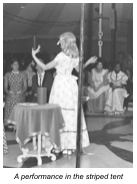 Before we bid farewell to our look at 1966, here are a few random things that happened that year. It was a weird and wonderful time!
Before we bid farewell to our look at 1966, here are a few random things that happened that year. It was a weird and wonderful time!The National Historic Preservation Act became law when President Lyndon B. Johnson signed off on it in October of 1966. While there were some similar actions taken before this — for instance, Teddy Roosevelt’s commitment to preserving our nation’s natural resources and archeological sites — this law encompassed a wide-range of things to be preserved. It established institutions like the National Register of Historic Places, the Advisory Council on Historic Preservation and the State Historic Preservation Office.

Earlier in the year, Jacqueline Susann released her blockbuster book “Valley of the Dolls.” The movie appeared already by the following year because “Dolls” was such a huge hit. While not very PC by today’s standards, it dished on sensational subjects like fame, drugs and sex that were a revelation to mid-sixties America and still relevant today.

This year Brookfield Zoo celebrated their 50th year of offering Mold-A-Rama figures. If you’re from Chicago, you probably made one in your youth and know that hot, waxy smell. “Miniature plastic factories” really took off at the New York City World’s Fair a few years before, but Chicago has the closest relationship. There are only a few places left that feature these antique machines. Brookfield offered special edition figures throughout the anniversary year, including the 1966 Walrus.
 Peppermint Patty also made her debut during the summer of 1966. She was the first female Peanuts character to not wear a dress — a nod to the growing women’s movement. Patty was unconventional in many ways, including having a particular close relationship with her single-parent dad.
Peppermint Patty also made her debut during the summer of 1966. She was the first female Peanuts character to not wear a dress — a nod to the growing women’s movement. Patty was unconventional in many ways, including having a particular close relationship with her single-parent dad.2016 comes to a close soon and no one knows what 2017 has in store, let alone what 2066 will be like. It’s amazing the things that seem odd and the things that remain familiar over a fifty year period. Can’t wait to see what unfolds!








































